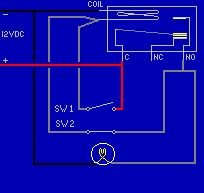|
First of
all, I would like to get you a little familiar with the parts in
this system. Even though there is only really 2 different kinds of
relays used they all serve a different purpose.
** The Multifunction Switch, Hazard Flasher, and Turn Signal Flasher
--
These are existing parts in your car already; I just added them into
the diagram so it was easier to see what was happening.
** The Alternate Turn Signal Relay & The Alternate Hazard Relay --
These relays activate opposite of the stock turn signal flasher and
hazard flasher. They basically supply power to the Left or Right
Selector Relays when the stock flashers are not. Which keeps the
selector relays on until you turn off your directionals.
** 4 Diodes --
These prevent back feed of voltage into your vehicles original turn
signal circuit.
** L. & R. Selector Relays --
These are basically the "on" switch to the whole system. One side of
the relay directs the Stop/Turn circuit to the Main Trigger Relay
when the turn signals are on, and to the L. & R. Seq/Std. Select
Relays when the brakes are pressed.
The other side turns the power on for the Sequencer Relays, the R. &
L. Seq/Std Select Relays, and supplies power to the common terminal
of the Alt. Turn Signal & Hazard Relays. Which actually supplies
power back to the coil of the L. & R. Selector Relays.
** Sequencer Relays (Bulb 1 - Reset) --
These relays are what actually get the work done. Each relay powers
the next one in sequential order. (No kidding, eh) They sequence
until the reset relay energizes and removes power from the Bulb 1
Relay. Which removes power from all of the Sequencer Relays. Then
the process starts over.
** L. & R. Seq/Std Select Relays --
These do 2 things. They mainly combine the three bulbs into 1
circuit for when the brakes are pressed or when the sequencer is
disabled. The other thing is that they keep the power to the
sequencer relays from back feeding from the left side to the right
side, and the other way around.
|
